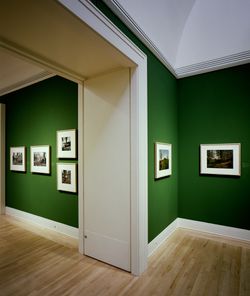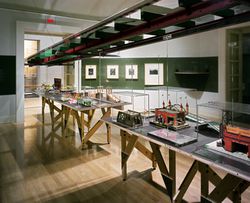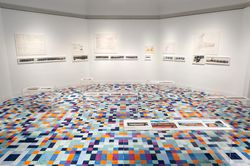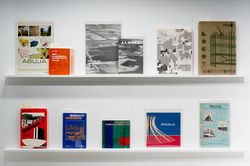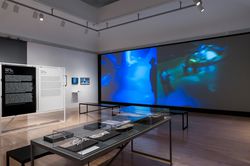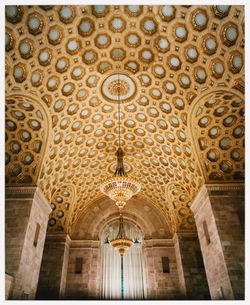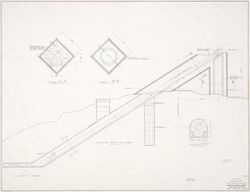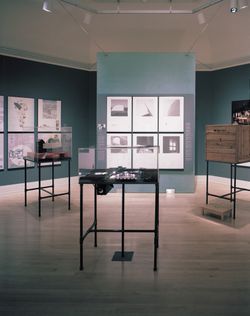Through a commission from the CCA, three contemporary photographers spent six years interpreting the work of Frederick Law Olmsted (1822–1903), North America’s most important landscape architect. *Viewing Olmsted: Photographs by Robert Burley, Lee Friedlander, and Geoffrey James* presents 155 photographs from this commission to offer visitors an opportunity to understand(...)
Main galleries
16 October 1996 to 2 February 1997
Viewing Olmsted: Photographs by Robert Burley, Lee Friedlander, and Geoffrey James
Actions:
Description:
Through a commission from the CCA, three contemporary photographers spent six years interpreting the work of Frederick Law Olmsted (1822–1903), North America’s most important landscape architect. *Viewing Olmsted: Photographs by Robert Burley, Lee Friedlander, and Geoffrey James* presents 155 photographs from this commission to offer visitors an opportunity to understand(...)
Main galleries
Second Life
Second Life searches for the particular places–real, imagined, and virtual–that exist somewhere outside of ordinary time and space, not only as a result of dreams but as a result of the natural phases of life.
27 March 2019 to 24 November 2019
Second Life
Actions:
Description:
Second Life searches for the particular places–real, imagined, and virtual–that exist somewhere outside of ordinary time and space, not only as a result of dreams but as a result of the natural phases of life.
Toys and Transport
Every new transportation link and every change in systems of urban mobility introduces new infrastructure to the urban landscape: massive cuts enabling railway tracks to converge at a terminal or junction; wide railyards that service suburban and metropolitan transit systems; the proliferation of bridges, ramps, elevated highways, freeway cuts, parking lots, and even(...)
Octagonal gallery
15 November 2000 to 1 April 2001
Toys and Transport
Actions:
Description:
Every new transportation link and every change in systems of urban mobility introduces new infrastructure to the urban landscape: massive cuts enabling railway tracks to converge at a terminal or junction; wide railyards that service suburban and metropolitan transit systems; the proliferation of bridges, ramps, elevated highways, freeway cuts, parking lots, and even(...)
Octagonal gallery
Toy Town
Toy Town explores how villages, towns, and cities have been represented in toys from Europe and North America. Drawn from CCA’s collection of architectural toys and games, the twenty-nine toys reflect shifting social values and different approaches to the design, organisation, and planning of communities in the nineteenth and twentieth centuries. Toy Town is the sixth in(...)
Octagonal gallery
22 October 1997 to 31 May 1998
Toy Town
Actions:
Description:
Toy Town explores how villages, towns, and cities have been represented in toys from Europe and North America. Drawn from CCA’s collection of architectural toys and games, the twenty-nine toys reflect shifting social values and different approaches to the design, organisation, and planning of communities in the nineteenth and twentieth centuries. Toy Town is the sixth in(...)
Octagonal gallery
Ábalos Herreros constructed landscapes—or, more precisely, assembled them—by crudely juxtaposing a cast of semi-familiar characters. Novel to Spanish architecture in the 1980s, this pragmatic method of appropriation was developed and consistently employed as part of their design process. Borrowing, incorporating and transforming allowed ÁbalosHerreros to absorb the(...)
Octagonal gallery
23 July 2015 to 13 September 2015
Landscapes of the Hyperreal: Ábalos&Herreros selected by SO – IL
Actions:
Description:
Ábalos Herreros constructed landscapes—or, more precisely, assembled them—by crudely juxtaposing a cast of semi-familiar characters. Novel to Spanish architecture in the 1980s, this pragmatic method of appropriation was developed and consistently employed as part of their design process. Borrowing, incorporating and transforming allowed ÁbalosHerreros to absorb the(...)
Octagonal gallery
Old Books New Cities
The pressing need to reconstruct cities after the Second World War and the sudden post-war rise in population led the public sector to assume an ever-increasing role in the design and construction of the urban environment. In different political contexts, large urban developments or the construction of entirely new towns were directed by municipal or state powers and(...)
Hall cases
12 December 2013 to 15 June 2014
Old Books New Cities
Actions:
Description:
The pressing need to reconstruct cities after the Second World War and the sudden post-war rise in population led the public sector to assume an ever-increasing role in the design and construction of the urban environment. In different political contexts, large urban developments or the construction of entirely new towns were directed by municipal or state powers and(...)
Hall cases
Media and Machines marks the second phase of the research project initiated with the 2013 exhibition Archaeology of the Digital. This initiative investigates how architecture engaged with digital technology from the 1980s until the turn of the century. The first exhibition identified the earliest practices looking to computation as a design medium that could serve(...)
Main galleries
21 May 2014 to 5 October 2014
Archaeology of the Digital: Media and Machines
Actions:
Description:
Media and Machines marks the second phase of the research project initiated with the 2013 exhibition Archaeology of the Digital. This initiative investigates how architecture engaged with digital technology from the 1980s until the turn of the century. The first exhibition identified the earliest practices looking to computation as a design medium that could serve(...)
Main galleries
Money Matters: A Critical Look at Bank Architecture surveys the history and cultural significance of bank architecture, focusing on bank architecture as a building typology rather than in the context of a single architect or architectural firm. Challenging the standard notion that bank buildings are repetitive, dull and conservative, the exhibition reveals banks as(...)
Main galleries
14 November 1990 to 24 February 1991
Money Matters: A Critical Look at Bank Architecture
Actions:
Description:
Money Matters: A Critical Look at Bank Architecture surveys the history and cultural significance of bank architecture, focusing on bank architecture as a building typology rather than in the context of a single architect or architectural firm. Challenging the standard notion that bank buildings are repetitive, dull and conservative, the exhibition reveals banks as(...)
Main galleries
Myron Goldsmith’s architectural works show how an economy of means and a modest approach can generate a profoundly poetic expression. Myron Goldsmith: Poet of Structure reveals how the architect’s methods and ideas are formed, developed, and disseminated by drawing upon the body of notes, sketchbooks, and study documents found in the collection of Goldsmith’s personal(...)
Main galleries
13 March 1991 to 2 June 1991
Myron Goldsmith: Poet of Structure
Actions:
Description:
Myron Goldsmith’s architectural works show how an economy of means and a modest approach can generate a profoundly poetic expression. Myron Goldsmith: Poet of Structure reveals how the architect’s methods and ideas are formed, developed, and disseminated by drawing upon the body of notes, sketchbooks, and study documents found in the collection of Goldsmith’s personal(...)
Main galleries
The exhibition presents the work of a generation of Japanese architects that reached architectural maturity at a time of unprecedented wealth in Japan. The six young architects included—Kiyoshi Sey Takeyama/AMORPHE; Norihiko Dan; Hiroyuki Wakabayashi; WORKSHOP; Hisashi Hara; and Atsushi Kitagawara—freely incorporate Western and Japanese architectural traditions. For this(...)
Octagonal gallery
17 April 1991 to 30 June 1991
Emerging Japanese Architects of the 1990s
Actions:
Description:
The exhibition presents the work of a generation of Japanese architects that reached architectural maturity at a time of unprecedented wealth in Japan. The six young architects included—Kiyoshi Sey Takeyama/AMORPHE; Norihiko Dan; Hiroyuki Wakabayashi; WORKSHOP; Hisashi Hara; and Atsushi Kitagawara—freely incorporate Western and Japanese architectural traditions. For this(...)
Octagonal gallery
